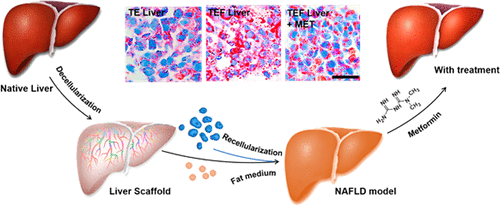当前位置:
X-MOL 学术
›
ACS Biomater. Sci. Eng.
›
论文详情
Our official English website, www.x-mol.net, welcomes your
feedback! (Note: you will need to create a separate account there.)
Establishment of an ex Vivo Model of Nonalcoholic Fatty Liver Disease Using a Tissue-Engineered Liver
ACS Biomaterials Science & Engineering ( IF 5.4 ) Pub Date : 2018-07-05 00:00:00 , DOI: 10.1021/acsbiomaterials.8b00652 Qiao Wu 1, 2 , Juan Liu 2 , Lijin Liu 2 , Yu Chen 1 , Jie Wang 2 , Ling Leng 2 , Qunfang Yu 2 , Zhongping Duan 1 , Yunfang Wang 2
ACS Biomaterials Science & Engineering ( IF 5.4 ) Pub Date : 2018-07-05 00:00:00 , DOI: 10.1021/acsbiomaterials.8b00652 Qiao Wu 1, 2 , Juan Liu 2 , Lijin Liu 2 , Yu Chen 1 , Jie Wang 2 , Ling Leng 2 , Qunfang Yu 2 , Zhongping Duan 1 , Yunfang Wang 2
Affiliation

|
The prevalence of nonalcoholic fatty liver disease (NAFLD), a common cause of chronic liver disease, continues to increase in parallel with that of obesity. Currently, there are no preclinical models to study its complex pathogenesis nor to assess candidate therapies. We have established a tissue-engineered (TE) liver by seeding cells into liver-derived matrix scaffolds and then perfusing the scaffolds with a medium that dynamically provides requisite nutrients, vitamins, minerals, and hormones. Liver-specific biomatrix scaffolds, comprised of almost all of the liver’s known extracellular matrix (ECM) components and matrix-bound soluble signals (e.g., growth factors/cytokines), were recellularized with human hepatic cell line HepG2 and perfused with a complete medium enabling the cells to form functioning liver tissue. By perfusing the system with medium with a high fat content, the cells established a TE fatty (TEF) liver model paralleling that of livers in NAFLD patients. The high fat medium containing 500 μM of free fatty acids (FFAs) (oleic acid:palmitic acid = 2:1) caused the TEF livers to accumulate 2-times more fat than those in the control medium over an 8 day culture period and significantly influenced the capacity of fatty acid synthesis and metabolism. PDK4, CYP2E1, and CYP7A1 genes associated with NAFLD and other liver diseases were all up-regulated, and the metabolic activity of CYP3A4 was significantly impaired. Excess FFAs also induced alterations in transporters and key enzymes in the lipid biosynthesis pathway. The TEF liver was used to test if an antisteatotic drug, Metformin, used in patients with NAFLD, would be able to provide effects paralleling those observed in some patients. Metformin treatment of the TEF liver model caused reduced cellular triglycerides, activated AMPK molecule, inhibited mTORC1 signaling pathway, which thus affected the synthesis and metabolism of FFAs. Overall, the TEF liver offers a stable and reproducible model to study the NAFLD development process and antisteatotic drug effects.
中文翻译:

使用组织工程化肝脏建立非酒精性脂肪肝疾病体内模型的建立
非酒精性脂肪肝疾病(NAFLD)的流行是慢性肝病的常见原因,与肥胖症的流行同时持续增加。目前,尚无临床前模型来研究其复杂的发病机制或评估候选疗法。我们已经建立了组织工程化(TE)肝脏,方法是将细胞播种到肝源性基质支架中,然后用动态提供必需营养素,维生素,矿物质和激素的培养基灌注支架。肝脏特异性生物基质支架,包括几乎所有肝脏已知的细胞外基质(ECM)成分和基质结合的可溶性信号(例如,生长因子/细胞因子),都用人类肝细胞系HepG2重新细胞化,并灌注了完整的培养基,使细胞形成功能性肝组织。通过在系统中注入高脂肪含量的培养基,这些细胞建立了与NAFLD患者肝脏相似的TE脂肪(TEF)肝脏模型。含有500μM游离脂肪酸(FFA)(油酸:棕榈酸= 2:1)的高脂培养基在8天的培养期内使TEF肝脏的脂肪堆积比对照培养基多2倍,并且显着影响了脂肪酸合成和代谢的能力。与NAFLD和其他肝脏疾病相关的PDK4,CYP2E1和CYP7A1基因均上调,并且CYP3A4的代谢活性显着受损。过量的FFA还诱导脂质生物合成途径中的转运蛋白和关键酶的改变。TEF肝脏用于测试NAFLD患者使用的抗硬脂药物二甲双胍,能够提供与某些患者所观察到的效果相似的效果。二甲双胍对TEF肝模型的治疗导致细胞甘油三酯减少,AMPK分子活化,抑制mTORC1信号通路,从而影响FFA的合成和代谢。总体而言,TEF肝脏为研究NAFLD的发育过程和抗脂肪变性药物的作用提供了一个稳定且可重现的模型。
更新日期:2018-07-05
中文翻译:

使用组织工程化肝脏建立非酒精性脂肪肝疾病体内模型的建立
非酒精性脂肪肝疾病(NAFLD)的流行是慢性肝病的常见原因,与肥胖症的流行同时持续增加。目前,尚无临床前模型来研究其复杂的发病机制或评估候选疗法。我们已经建立了组织工程化(TE)肝脏,方法是将细胞播种到肝源性基质支架中,然后用动态提供必需营养素,维生素,矿物质和激素的培养基灌注支架。肝脏特异性生物基质支架,包括几乎所有肝脏已知的细胞外基质(ECM)成分和基质结合的可溶性信号(例如,生长因子/细胞因子),都用人类肝细胞系HepG2重新细胞化,并灌注了完整的培养基,使细胞形成功能性肝组织。通过在系统中注入高脂肪含量的培养基,这些细胞建立了与NAFLD患者肝脏相似的TE脂肪(TEF)肝脏模型。含有500μM游离脂肪酸(FFA)(油酸:棕榈酸= 2:1)的高脂培养基在8天的培养期内使TEF肝脏的脂肪堆积比对照培养基多2倍,并且显着影响了脂肪酸合成和代谢的能力。与NAFLD和其他肝脏疾病相关的PDK4,CYP2E1和CYP7A1基因均上调,并且CYP3A4的代谢活性显着受损。过量的FFA还诱导脂质生物合成途径中的转运蛋白和关键酶的改变。TEF肝脏用于测试NAFLD患者使用的抗硬脂药物二甲双胍,能够提供与某些患者所观察到的效果相似的效果。二甲双胍对TEF肝模型的治疗导致细胞甘油三酯减少,AMPK分子活化,抑制mTORC1信号通路,从而影响FFA的合成和代谢。总体而言,TEF肝脏为研究NAFLD的发育过程和抗脂肪变性药物的作用提供了一个稳定且可重现的模型。











































 京公网安备 11010802027423号
京公网安备 11010802027423号